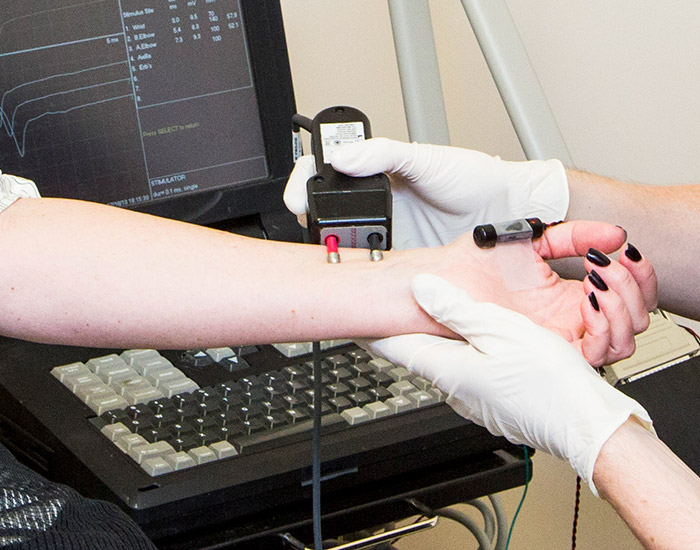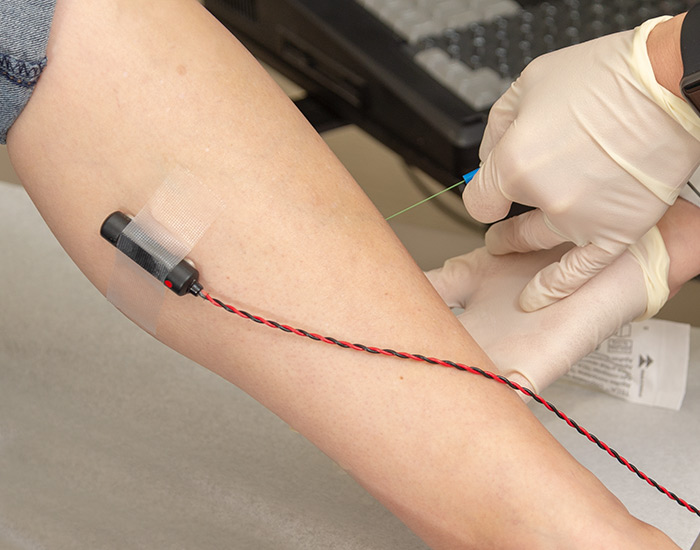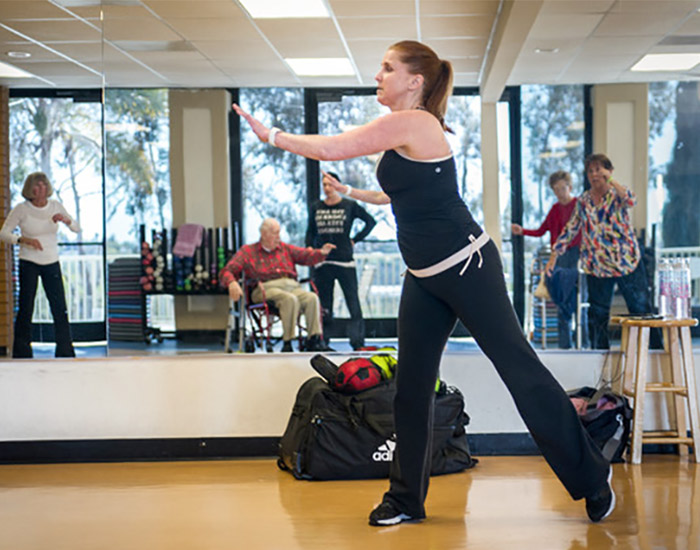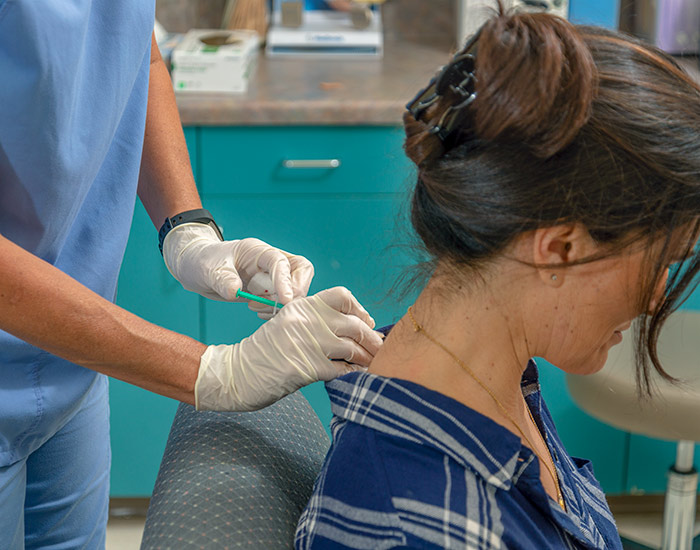Clinic
Neuromuscular
Our neurodiagnostic team, under the supervision of Dr. Martinez, conducts Electromyography (EMG) and nerve conduction studies (NCS) to help confirm or rule out the presence of neuromuscular conditions such as:
- Carpal Tunnel Syndrome (CTS)
- Ulnar Nerve Palsy
- Myelopathy
- Neuropathy
- Radiculopathy
- Guillain Barre syndrome
- Charcot-Marie Tooth disease
- Herniated disk disease
- Chronic inflammatory polyneuropathy
- Sciatic nerve problems
While treatments can vary from Occupational and Physical Therapy to medication management or surgery, you can count on a rapid diagnosis and a personal treatment plan administered by our dedicated medical team, technicians and support staff.
Diagnostic Tests
In addition to taking a complete health history and a neurological evaluation, our neurodiagnostic team conducts tests and procedures that are vital tools to help rule out or confirm the presence of a neurological disorder or other medical condition. At the Neurology and Pain Specialty Center, the following diagnostic tests are available:
- A nerve conduction study (NCS) test, also called a nerve conduction velocity (NCV) test, measures electrical energy by assessing the nerve’s ability to send a signal.
- Usually done in conjunction with an NCS , the Electromyogram is used to diagnose nerve and muscle dysfunction and spinal cord disease.
- Other tests that may be ordered include lab work (blood tests), MRI, CT, Ultrasound, lumbar puncture and nerve or muscle biopsy.

Treatments
Treatments for neuromuscular conditions vary widely, depending upon the disease or disorder. For information, ask your physician or advanced practitioner and learn more about the condition under Common Neurological Conditions.
Patient Tips
- Wear clothing that allows access up to your shoulder or knee
- Do not use any cologne, lotion or perfume prior to testing
- Generally, you will not need to fast or get sedation before the procedure
- Tell your healthcare provider of all medicines (prescription and over-the-counter) and herbal supplements that you take
Specialized care we offer:

Nerve Conduction Study (NCS)
NCS is a measurement of the amount and speed of conduction of an electrical impulse through a nerve. NCS can determine nerve damage and destruction, and is often performed at the same time as EMG. Both procedures help to detect the presence, location, and extent of diseases that damage the nerves and muscles.
Before the procedure:
- Your Practitioner and Neurodiagnostic tech will explain the procedure to you and offer you the opportunity to ask any questions that you might have about the procedure.
- Generally, no fasting or sedation is required prior to the procedure.
- Notify your Practitioner and/or Dr. Martinez of all medications (prescribed and over-the-counter) and herbal supplements that you are taking.
- Dress in clothes that permit access to the area to be tested or that are easily removed.
- Stop using lotions or oils on your skin for a few days before your procedure, or at least stop using them on the day of the exam.
- Based on your medical condition, your Practitioner or Dr. Martinez may request other specific preparation.
During the procedure:
- Your nerve conduction study will be performed on an outpatient basis. The NCS is performed by one of our specially trained neurodiagnostic technicians
Generally, our NCS procedures follow this process:
- You will be asked to remove any clothing, jewelry, hairpins, eyeglasses, hearing aids, or other metal objects that may interfere with the procedure. If you are asked to remove clothing, you will be given a gown to wear.
- You will be asked to sit or lie down for the test.
- One of our Neurodiagnostic techs will locate the nerve(s) to be studied.
- A recording electrode will be attached to the skin over the nerve with a special paste and a stimulating electrode will be placed at a known distance away from the recording electrode.
- The nerve will be stimulated by a mild and brief electrical shock given through the stimulating electrode.
- You may experience minor discomfort for a few seconds.
- The stimulation of the nerve and the detected response will be displayed in the form of waves.
After the procedure:
- The gel used to attach the electrodes will be removed from your skin.
After the test, you may return to your previous activities, unless you are advised differently.

Electromyography (EMG)
Electromyography (EMG) measures muscle response or electrical activity in response to a nerve’s stimulation of the muscle. The test is used to help detect neuromuscular abnormalities. During the test, one or more small needles (also called electrodes) are inserted through the skin into the muscle. The electrical activity picked up by the electrodes and recorded in form of waves. An audio-amplifier is used so the activity can be heard. EMG measures the electrical activity of the muscle during rest, slight contraction and forceful contraction. Muscle tissue does not normally produce electrical signals during rest. When an electrode is inserted, a brief period of activity can be seen, but after that, no signal should be present.
After an electrode has been inserted, you may be asked to contract the muscle, for example, by lifting or bending your leg. The action potential (size and shape of the wave) that this creates provides information about the ability of the muscle to respond when the nerves are stimulated. As the muscle is contracted more forcefully, more and more muscle fibers are activated, producing action potentials.
Before the procedure:
- Your Practitioner and Dr. Martinez will explain the procedure to you and offer you the opportunity to ask any questions that you might have about the procedure.
- Generally, fasting is not required before the test. In some cases, cigarettes and caffeinated beverages, such as coffee, tea, and cola may be restricted two to three hours before testing.
- Notify you’re your Practitioner and Dr. Martinez of all medications (prescribed and over-the-counter) and herbal supplements that you are taking.
- Notify your Practitioner and Dr. Martinez if you have a pacemaker.
- Dress in clothes that permit access to the area to be tested or that are easily removed.
- Stop using lotions or oils on your skin for a few days before your procedure, or at least stop using them on the day of the exam.
- Based on your medical condition, your Practitioner or Dr. Martinez may request other specific preparation.
During the procedure:
An EMG procedure may be performed on an outpatient basis. The EMG is performed by Dr. Martinez. The EMG is usually performed immediately following a nerve conduction study (a test that measures the flow of current through a nerve before it reaches the muscle rather than the response of muscle itself).
Generally, an EMG procedure follows this process:
- You will be asked to remove any clothing, jewelry, hairpins, eyeglasses, hearing aids, or other metal objects that may interfere with the procedure. If you are asked to remove clothing, you will be given a gown to wear.
- You will be asked to sit or lie down for the test.
- Martinez will locate the muscle(s) to be studied.
- The skin will be cleansed with an antiseptic solution. Next, a fine, sterile needle will be inserted into the muscle. A ground electrode will be positioned under your arm or leg.
- Five or more needle insertions may be necessary for the test. You may experience slight pain with the insertion of the electrode, but it is usually painless.
- If the test is painful you must tell your examiner because this can interfere with the results.
- You will be asked to relax and then perform slight or full-strength muscle contractions.
- The electrical activity from your working muscle will be measured.
- An audio amplifier may also be used so that both the appearance and sound of the electrical potentials can be evaluated. If the recorder is attached to an audio amplifier, you may hear a sound like hail on a tin roof when you contract your muscle.
After the procedure:
- Some muscle soreness may persist for a day or so following the procedure. Notify our office if you experience increasing pain, tenderness, swelling, or pus at the needle insertion sites. Your Practitioner or Dr. Martinez may give you additional or alternate instructions after the procedure, depending on your particular situation.

Outpatient Neuro Rehab
Our goal is to help you regain optimal function and quality of life. Our team will assist in coordinating your rehab services with one of our patient-centered, educational and neuro-rehab focused physical therapy centers.
Conditions that may affect mobility
- Stroke
- Ataxia
- Orthopedic Deficits / Post Orthopedic Surgery
- Neuropathies — Peripheral Neuropathy, Poly Neuropathy
- Guillain-Barre Syndrome
- Concussion / Post-Concussion Syndrome
- Parkinson’s Disease
- Normal Pressure Hydrocephalus (NPH)
- The Older Adult Deconditioning/Disuse
Goals for Neuro Rehabilition
- Educate the patient regarding the disease state and process
- Provide activities to improve muscle control and balance in entire body
- Improve function, safety, and efficiency of movement
- Prevent or postpone weakness caused by declining activity
- Manage spasticity, improve muscle control and flexibility
- Develop the maximum potential of muscle, bone, and respiration
- Set short and long term goals involving the individual and family members
- Helping the individual return to the highest level of function, regain abilities, and improve their quality of life.

Medication Therapies
People with neuromuscular pain experience different types/degrees of pain. It’s important to communicate this information with Dr. Martinez and your Advanced Practitioner so we can identify the type of medication that will work best for managing you individual symptoms and also work with your body chemistry and compliment any other treatments.
Over the Counter Treatments
- Over the counter Pain Medication- Acetaminophen and Nonsteroidal anti-inflammatory drugs (NSAIDs)
- Topical Medications- local anesthetics or Analgesics
- Transcutaneous Electronic Nerve Stimulation (TENS)
Prescription Treatments
When over-the-counter pain medications do not relieve the pain associated with neuromuscular conditions, other types of medications and therapies are available, including prescription nonsteroidal anti-inflammatory drugs, antidepressants, nerve blocks and topical medications.
Alternative Therapies
Many patients find that complementary therapies help manage neuropathic pain. Complementary therapies are drug-free treatments that are non-invasive and support the idea that the body will work to heal itself. They may be used alone or may be combined with other medications and treatment options.
- Acupuncture
- Biofeedback
- Splints
- Relaxations — including breathing exercises, visualization, meditation and yoga
Key Neuromuscular Clinic Staff
-
-
-
-
 Tim Harvey Neurodiagnostic Technician
Tim Harvey Neurodiagnostic Technician -
 Michael Husava Neurodiagnostic Technician
Michael Husava Neurodiagnostic Technician -
 Salina Gomez, M.A. Medical Assistant / Authorization Coordinator
Salina Gomez, M.A. Medical Assistant / Authorization Coordinator -
 Robert Weldy Neurodiagnostic Technician
Robert Weldy Neurodiagnostic Technician



